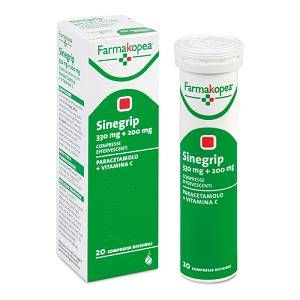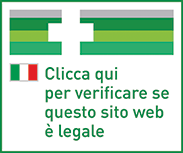Ship in Europe, Find out rates!
Language
Sinegrip 20 Tablets Eff 330mg + 200mg

Regular Price
€5.50
Special Price
€3.74
-32%
Save: €1.76
Out of stock
- box Delivery in Italy in 24/48 and free returns
- star3.000+ positive reviews
- dropboxOver 60,000 products in the catalog
Manufacturer
FARMAKOPEA
SKU
035755014
Active principle
PARACETAMOLO/ACIDO ASCORBICO
NAME
SINEGRIP 330 MG + 200 MG EFFERVESCENT TABLETS
PHARMACOTHERAPEUTIC CATEGORY
Other analgesics and antipyretics, anilides (paracetamol, combinations except psycholeptics).
ACTIVE PRINCIPLES
One effervescent tablet contains: paracetamol 330 mg and sodium ascorbate 224 mg corresponding to vitamin C 200 mg.
EXCIPIENTS
Citric acid, sodium bicarbonate, sorbitol, anhydrous sodium carbonate, aspartame, orange flavor, lemon flavor, dimethicone, polysorbate 20, povidone.
INDICATIONS
Symptomatic treatment of painful affections of all kinds and of fever and cold affections.
CONTRAINDICATIONS / SECONDARY EFFECT
Hypersensitivity 'to the active ingredients or to any of the excipients. Patients with manifest insufficiency of glucose-6-phosphate dehydrogenase and in those with severe haemolytic anemia. Severe hepatocellular insufficiency. Children under the age of 7.
DOSAGE
Adults (over 15 years): 1-2 tablets 3 times a day in a glass of water with a minimum interval of 4 hours between each intake. Children and boys. From 7 to 13 years: half-1 tablet 1-3 times a day in a glass of water; from 13 to 15 years: 1-1 and a half tablet 1-3 times a day in a glass of water. In children from 7 to 12 years the product should be administered with caution. Elderly patients should stick to the minimum dosages.
STORAGE
This medicine does not require any special storage conditions.
WARNINGS
High or prolonged doses of the product can cause high-risk liver disease and alterations, even serious ones, to the kidney and blood. Do not administer during chronic treatment with drugs that can determine the induction of hepatic monooxygenases or in case of exposure to substances that can have this effect. Paracetamol should be administered with caution in subjects with renal or hepatic insufficiency. During treatment with paracetamol, before taking any other drug, check that it does not contain the same active ingredient. Instruct the patient to contact the physician before associating any other medication. In case of allergic reactions the administration should be suspended. Do not administer for more than 3 consecutive days. Contains aspartame.
INTERACTIONS
During therapy with oral anticoagulants it is recommended to reduce the doses. Use with extreme caution and under strict control during chronic treatment with drugs that can determine the induction of hepatic monooxygenases or in case of exposure to substances that can have this effect. The administration of paracetamol can interfere with the determination of uricemia and with that of glycaemia.
SIDE EFFECTS
Skin reactions of various types and severity have been reported with the use of paracetamol, including cases of erythema multiforme, Stevens-Johnson syndrome and epidermal necrolysis. Hypersensitivity reactions have been reported. In addition, the following undesirable effects have been reported: thrombocytopenia, leukopenia, anemia, agranulocytosis, impaired liver function and hepatitis, renal changes, gastrointestinal reactions and dizziness. In case of overdose, paracetamol can cause hepatic cytolysis which can evolve towards massive and irreversible necrosis.
PREGNANCY AND BREASTFEEDING
Use only in cases of actual need.
SINEGRIP 330 MG + 200 MG EFFERVESCENT TABLETS
PHARMACOTHERAPEUTIC CATEGORY
Other analgesics and antipyretics, anilides (paracetamol, combinations except psycholeptics).
ACTIVE PRINCIPLES
One effervescent tablet contains: paracetamol 330 mg and sodium ascorbate 224 mg corresponding to vitamin C 200 mg.
EXCIPIENTS
Citric acid, sodium bicarbonate, sorbitol, anhydrous sodium carbonate, aspartame, orange flavor, lemon flavor, dimethicone, polysorbate 20, povidone.
INDICATIONS
Symptomatic treatment of painful affections of all kinds and of fever and cold affections.
CONTRAINDICATIONS / SECONDARY EFFECT
Hypersensitivity 'to the active ingredients or to any of the excipients. Patients with manifest insufficiency of glucose-6-phosphate dehydrogenase and in those with severe haemolytic anemia. Severe hepatocellular insufficiency. Children under the age of 7.
DOSAGE
Adults (over 15 years): 1-2 tablets 3 times a day in a glass of water with a minimum interval of 4 hours between each intake. Children and boys. From 7 to 13 years: half-1 tablet 1-3 times a day in a glass of water; from 13 to 15 years: 1-1 and a half tablet 1-3 times a day in a glass of water. In children from 7 to 12 years the product should be administered with caution. Elderly patients should stick to the minimum dosages.
STORAGE
This medicine does not require any special storage conditions.
WARNINGS
High or prolonged doses of the product can cause high-risk liver disease and alterations, even serious ones, to the kidney and blood. Do not administer during chronic treatment with drugs that can determine the induction of hepatic monooxygenases or in case of exposure to substances that can have this effect. Paracetamol should be administered with caution in subjects with renal or hepatic insufficiency. During treatment with paracetamol, before taking any other drug, check that it does not contain the same active ingredient. Instruct the patient to contact the physician before associating any other medication. In case of allergic reactions the administration should be suspended. Do not administer for more than 3 consecutive days. Contains aspartame.
INTERACTIONS
During therapy with oral anticoagulants it is recommended to reduce the doses. Use with extreme caution and under strict control during chronic treatment with drugs that can determine the induction of hepatic monooxygenases or in case of exposure to substances that can have this effect. The administration of paracetamol can interfere with the determination of uricemia and with that of glycaemia.
SIDE EFFECTS
Skin reactions of various types and severity have been reported with the use of paracetamol, including cases of erythema multiforme, Stevens-Johnson syndrome and epidermal necrolysis. Hypersensitivity reactions have been reported. In addition, the following undesirable effects have been reported: thrombocytopenia, leukopenia, anemia, agranulocytosis, impaired liver function and hepatitis, renal changes, gastrointestinal reactions and dizziness. In case of overdose, paracetamol can cause hepatic cytolysis which can evolve towards massive and irreversible necrosis.
PREGNANCY AND BREASTFEEDING
Use only in cases of actual need.


